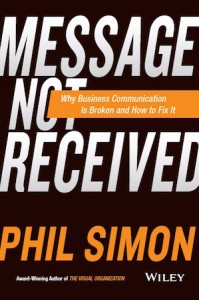A few weeks ago, I sent off an email to Phil Simon, with my phone number, asking him to give me a call to discuss book publicists.

I had figured email wasn't the best form of communication for this discussion—and I couldn't have been more right.
Little did I know that author and—oops I almost used the word technologist—Phil Simon, would appreciate my choosing the most direct and appropriate communication medium for what I wanted to discuss.
In fact, he actually wrote a book on precisely that topic, “Message Not Received: Why Business Communication Is Broken and How to Fix It.”
When, I first meet someone, I can usually tell right from the start of the conversation whether or not they've read Dale Carnegie's classic book, “How to Win Friends and Influence People.”
I didn't have to read Phil's book, where he mentions Dale's masterpiece, to know he had read it.
Phil is the kind of guy who's difficult not to like.
Once Phil had heard about my book, “Soft Skills,” he immediately offered some sage advice as well as volunteered to help me promote the book, by posting a review on his website.
Not only did Phil make good on his promise—a rare thing to see today—but, he posted a Q&A about my book on Huffington Post!
Thanks, Phil!
On to the book, “Message Not Received”

I initially had intended to give “Message Not Received” a quick scan, but that was not possible. As soon as I started reading, I was sucked right in, beginning with the excellent preface where Phil uses a few interesting stories to demonstrate the pervasive problem in much of corporate America—and in all of our lives today: the failure to communicate.
Phil goes on to show concrete examples and research that shows just how important and widespread this communication problem that plagues us today is.
Techno-jargon and buzzwords have permeated all areas of our lives and Phil is on a personal mission to stop the proliferation, when plain, simple language, tailored to your audience, will suffice.
As I read through the book, I found myself guilty of using such words and phrases as “low-hanging fruit,” “leverage,” “synergy,” and more—in fact, I as I am writing this I have to make a conscious effort to avoid the obscure terms and instead focus on simple language.
But, Phil's message in “Message Not Received” isn't just that CEOs need to stop using buzzwords and say what they mean in plain English, he also digs into just how much technology and new forms of communication are drowning us in data and what we can do to deal with it and not continue to be part of the problem.
Phil clearly understands the plight of the average American worker trying to decipher cryptic communications from their bosses and coworkers, all the while trying to keep some semblance of a work-life balance when they are essentially on-call 24 hours a day.
There is no doubt, the world we live in is more connected than ever before and Phil is trying to help us sort it all out by learning how to deal effectively with email, send clear messages and select the appropriate channels for communication.
“Message Not Received” is filled with horror stories of communication gone wrong, but also examples and advice on how to do it right.
Honestly, anyone who's ever either read an email from their boss that had the words “paradigm shift” in it, or wrote those very words themselves, should read this book.
(Just to let you know, at the time of writing this review, the book hasn't officially published yet, but you can still reserve a copy on Amazon.)
